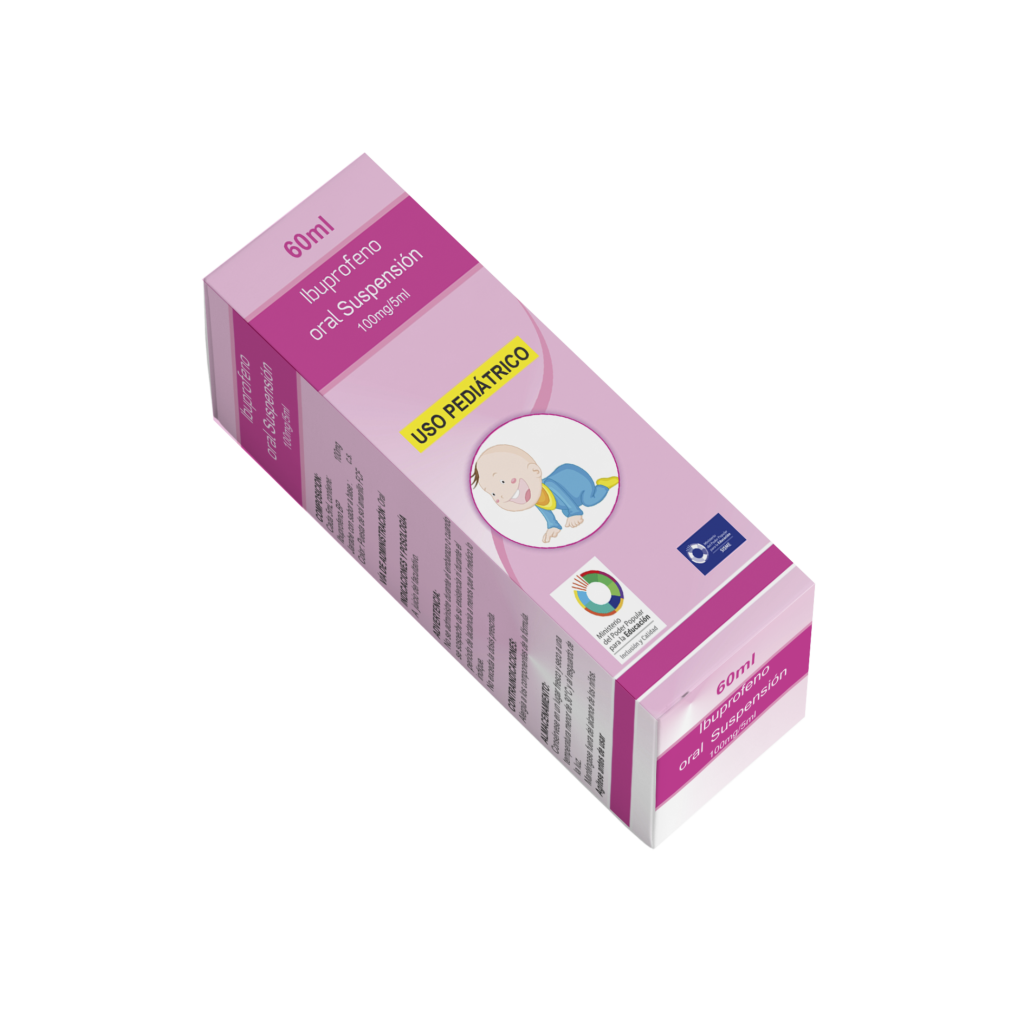
Children 3 months to 12 years (> 5 kg):
the reduction of fever, including post immunisation pyrexia
the relief of the symptoms of colds and influenza
the relief of mild to moderate pain, such as a sore throat, teething pain, toothache, earache, headache, minor aches and sprains.
Undesirable effects may be minimized by using the lowest effective dose for the shortest duration necessary to control symptoms.
Children, from 3 months of age
For post immunisation pyrexia: One 2.5 ml dose followed by one further 2.5 ml dose 6 hours later if necessary. No more than two 2.5 ml doses in 24 hours. If the fever is not reduced, consult your doctor.
For pain, fever and symptoms of cold and influenza: The daily dosage of Ibuprofen oral suspension is 20-30 mg/kg body weight in divided doses. Using the oral dosing syringe provided this can be achieved as follows:
Infants 3 – 6 months weighing more than 5 kg: One 2.5ml dose may be taken 3 times in 24 hours.
Infants 6 – 12 months (7 – 10 kg): One 2.5 ml dose may be taken 3 to 4 times in 24 hours.
Children 1 – 3 years (10 – 15 kg): One 5 ml dose may be taken 3 times in 24 hours.
Children 4 – 6 years (15 – 20 kg): 7.5 ml may be taken 3 times in 24 hours.
Children 7 – 9 years (20 – 30 kg): 10 ml may be taken 3 times in 24 hours.
Children 10 – 12 years (30 – 40 kg): 15 ml may be taken 3 times in 24 hours.
Doses should be given approximately every 6 to 8 hours, (or with a minimum of 6 hours between each dose if required).
Infants under 3 months of age or weighing less than 5 kg should not take Ibuprofen due to lack of data on safety and efficacy.
The most commonly observed adverse events are gastrointestinal in nature. Peptic ulcers, perforation or GI bleeding, sometimes fatal, particularly in the elderly, may occur. Nausea, vomiting, diarrhoea, flatulence,constipation, dyspepsia, abdominal pain, melaena, heamatemesis, ulcerative stomatits, exacerbation of colitis and Crohn’s diseas have been reported following administration. Less frequently, gastritis has been observed.
As with other NSAIDs, ibuprofen may mask the signs of infection.
The elderly have an increased frequency of adverse reactions to NSAIDs especially gastrointestinal bleeding and perforation which may be fatal.
Bronchospasm may be precipitated in patients suffering from or with a previous history of bronchial asthma or allergic disease.
The use of Ibuprofen with concomitant NSAIDs including cyclooxygenase-2 selective inhibitors should be avoided
In patients with systemic lupus erythematosus (SLE) and mixed connective tissue disorders there may be an increased risk of aseptic meningitis.
Patients at greatest risk of suffering this reaction are those with renal dysfunction, heart failure, those taking diuretics or ACE-inhibitors and the elderly. Monitoring of renal function is necessary, especially in high risk patients. There is a risk of renal impairment in dehydrated children and adolescents.
Hepatic dysfunction
Caution (discussion with doctor or pharmacist) is required prior to starting treatment in patients with a history of hypertension and/or heart failure as fluid retention, hypertension and oedema have been reported in association with NSAID therapy.
There is some evidence that drugs which inhibit cyclo-oxygenase/prostaglandin synthesis may cause impairment of female fertility by an effect on ovulation. This is reversible on withdrawal of treatment.
GI bleeding, ulceration or perforation, which can be fatal, has been reported with all NSAIDs at any time during treatment, with or without warning symptoms or a previous history of serious GI events.
Serious skin reactions, some of them fatal, including exfoliative dermatitis, Stevens-Johnson syndrome, and toxic epidermal necrolysis, have been reported very rarely in association with the use of NSAIDs
Store below 30°C temperature. Protect from light.
Keep the medicine out of reach of children.
100 ml in Pet Bottle with Cap and measuring Cup. Such 01 bottle in a carton with pack insert.
Contact us directly to receive full information on the product, the formulation, the science behind it, stability data, and more. Our Business Development Manager is a click away.
Conical Pharmaceuticals is a professionally managed and dynamic organization with decades of experience in the pharmaceutical field. With a desire of providing opportunities for a better life, we work very hard to bring quality drugs to our customers. We have instilled a level of trust and confidence amongst our clients by supplying the best quality products.